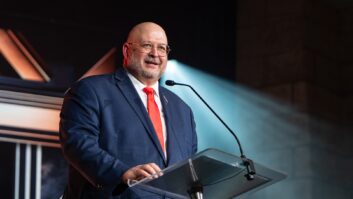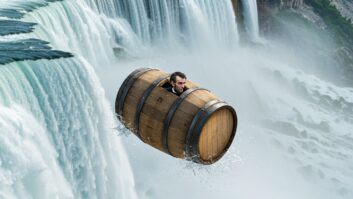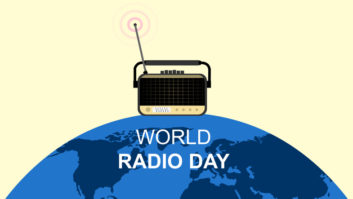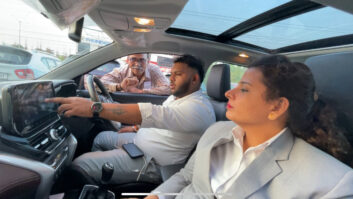The new talk of the town
Dec 1, 2002 12:00 PM, By Chriss Scherer, editor
EquipmentListAirtools 6100 delay
AKG K141 headphones
Antex LX-44 audio cards
Aphex 120A distribution amplifier
Aphex Compellers
Arrakis furniture
Belden 1854F wire and cable
Comrex Matrix w/ ISDN
Comrex Nexus ISDN codec
Conex tone generators and decoders
Cybex KVM extenders
Denon DN 720R cassette
ELO TouchSystems monitors
EV RE27 mics
Eventide BD500 delay
Fostex rack-mount monitors
Furman power conditioners
Gentner DH30 hybrid
Gepco Gep-flex wire and cable
Hafler P1000 amplifier
Harris IntraPlex T1 interface
JBL 4410 studio monitors
Logitek Audio Engines
Logitek Numix and Remora consoles
LPB Silent Mic Booms and risers
Mediatouch automation systemMicroboards Disc Factory CDburner
Microboards Orbit II CD burner
Microboards StartRec 400 CD burner
Middle Atlantic furniture
Middle Atlantic rack accessories
Middle Atlantic racks
MXL 2003 mics
NEC MultiSync LCD1700M+ monitors
OMT iMedialogger
Presonus ACP88 compressor limiters
Presonus M80 mic processors
Presonus MP20 mic processors
Rimage Auto Everest CD printer
Sony CDPXE370 CD players
Sony MDSE12 Minidiscs
Symetrix 506E headphone amps
Syntrillium Cool Edit Pro
Telos Assistant Producer software
Telos Desktop Director phones
Telos Twox12 ISDN phone system
Telos Zephyr Xstream ISDN codecs
Tieline Commander w/ ISDN Card

A major provider of syndicated talk programming and home towell-known personalities including Bruce Williams, Doug Stephan, MortCrim, Heloise and Barry Farber, Talk America Radio Networks hascompleted its new studio complex in Newark, NJ. This was a studio moveon a grand scale, taking the network operation more than halfway acrossthe country from its previous location in Las Vegas.
Talk America, owned by IDT Media, a division of IDT Corporation,moved to the East Coast to consolidate several IDT business divisionsinto one location, allowing them to share facilities and resources,including studios and other technical facilities. There are threecontrol rooms. Two rooms are designed for on-air use, while the thirdis used mainly for production. If needed, any studio can be used tofeed programming to the satellite uplink.
Studio A is the largest studio and includes an 18-fader console andcall screener booth.

While this installation looks similar to most radio facilities, ithas its own unique aspects. Creating network trigger tones is thebiggest difference between this facility and a traditional radiofacility. The studio move allowed Talk America to change how it dealswith generating these tones and keeping the schedule running ontime.
The facility’s audio is stored and delivered with a Mediatouchsystem. While the company has installed numerous systems for stationsthat receive satellite-delivered programming, this was the first timethat the system was being used by a program originator.
Breaking away from its old ways, and eliminating many of the commonproblems associated with satellite programming, Talk America uses theMediatouch system to generate the cue tones. Mediatouch did not have tomodify its software in any way. Instead, some operational methods wereapplied to allow the system to generate the cue tones and automaticallyschedule the fixed breaks.
The production studio is the smallest studio. The console, which sitson the tabletop and is connected by a few cables, can be placedwherever it is needed when the room is in use.

The local spot breaks are on a fixed time schedule. To eliminateslight variations in timing, these breaks are initiated by theMediatouch system. As a break approaches, a bumper begins to playautomatically, increasing in level to the final post. Likewise, once abreak has ended, the rejoiner is played.
Profanity delay operation is also handled through the automationsystem. The first five minutes of each hour are covered by a newscast,which needs to be in real time. When the top of the hour approaches,the automation system plays the show’s theme to the end and then dumpsthe delay, instantly joining real time. At the same instant, thenewscast begins. Once the news has finished, the show begins again anddelay is slowly added.
Satellite studios
Of all the programs carried by Talk America, only one host isactually in the studio facilities. The others contribute their showsfrom remote locations through ISDN codecs. The ISDN return carries alow-delay, mix-minus feed and an IFB. Additionally, some hosts havecomplete access to the Telos Assistant Producer call screening softwarethrough the data connection. The hosts have access and control of theircallers, the same as if they were in the studio with the telephoneequipment.
All the audio events are handled through the main studio. At theheart of the audio routing and switching is a Logitek Audio Engine.Each air studio has three ISDN codecs available for the greatestflexibility.
The Talk Studio is set up with minimal equipment between the host andthe guest, which makes guests feel more comfortable.

The smaller production studio is designed around the DAW. Theconsole, a Logitek Remora, is used primarily for line selection andlevel control of signals feeding the DAW. It is often pushed out of theway during a production session. If necessary, the production studiocan feed the network.
When a host plans to take time off, the network prefers to not rerunpreviously aired shows. Instead, a live show is prepared off line andplayed back in the time slot.
There are two primary on-air control rooms. Studio A also has acall-screener station. The facility’s rack room is in the corporatedata center, which is about 300 feet from the studios. It houses fiveracks and 150 punch blocks.
Studio A boasts as the largest console configuration with 18 faderson the control surface. Studio B houses a 12-fader control surface. Theproduction studio has a four-fader control surface.
Studio B, the mid-size studio, has a similar look and layout as StudioA. Any studio can be used to put the remote hosts� programs onthe air.

There are no system computers in any of the studios. The studios areconnected to their computers through Cybex extenders. In case of anautomation system failure, there are mirrored Mediatouch systemsrunning in tandem for complete redundancy. If one system fails, theother can be brought up to take control. As a further safeguard, thenetwork tries to run backup programs on the second system in case ashow host’s ISDN connection is lost. Also, to aid troubleshooting, oneMediatouch OpLog system is set up as a receive station to verify thatall tones and cues are being sent and received properly.
The completed audio program and its embedded cue tones are sent toABC Satellite Services to be uplinked. Program audio for both channelsis sent via a T1 on the Harris IntraPlex system with an ISDN backupready to go if needed.
Talk America’s new facilities are designed to serve the needs of thenetwork, as well as some additional demand from its collocated parentcompany. The network currently serves nearly 1,000 affiliates, andboasts one of the most varied lineups of talk shows available duringits weekday service.







